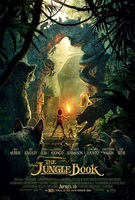
Man vs. Nature in The Jungle Book (2016)
The Jungle Book is a film that essentially explores the relationship between man and nature through the portrayal of different animal wills and how they respond to one another, forming a variety of tensions and friendships. This unfolds through the story of Mowgli, a boy raised by wolves in the jungle, and the experiences that entail when the Bengal tiger Shere Khan decides that he wants him dead due to his resentment of mankind. Mowgli leaves his pack of wolves guided by Bagheera, a wise and loyal panther who strives to escort Mowgli to safety in the man-village. Along the way Mowgli encounters the highly respected elephants of the jungle, the dangerous but knowledgeable Kaa the snake, the relaxed and fun-loving Baloo the bear and the overbearing King Louie with his mischievous monkey pack to name a few of the 224 unique animals created by the use of computer-generated imagery.[1]
The film follows Disney’s current trend of using modern technological advancements to reimagine their popular classics. The Jungle Book was initially a collection of stories written by Rudyard Kipling in 1894, but since then the characters and images have resonated in the hearts and minds of many through Disney’s 1967 vision. Jon Favreau’s 2016 remake may surpass expectations established by the feel of the family friendly cartoon, with this new version possessing a much darker tone.
In his interview with Collider, Favreau notes that he returns to the “strong mythic theme” of Kipling’s work,[2] with this partly being achieved by screen writer Justin Marks taking new dialogue directly from Kipling’s original writing. This mythicism is enhanced by the godlike abilities assigned to the elephants, in addition to the introduction of ‘the Jungle Pact’ and the significance of the element of fire and it’s symbolic name “the red flower”.
This thematic shift causes a much more blurred boundary between a children and adult’s film, which partially explains its vast box office success. A more action driven plot comes with this darker tone; the escape from and eventual defeat of Shere Khan is a prominent theme from beginning to end, causing many intense chase and fight scenes. Characters that provide comic relief or nostalgic capacity remain, but Mowgli’s 2016 journey largely entails a more serious exploration of interaction between man, animals and the environment.
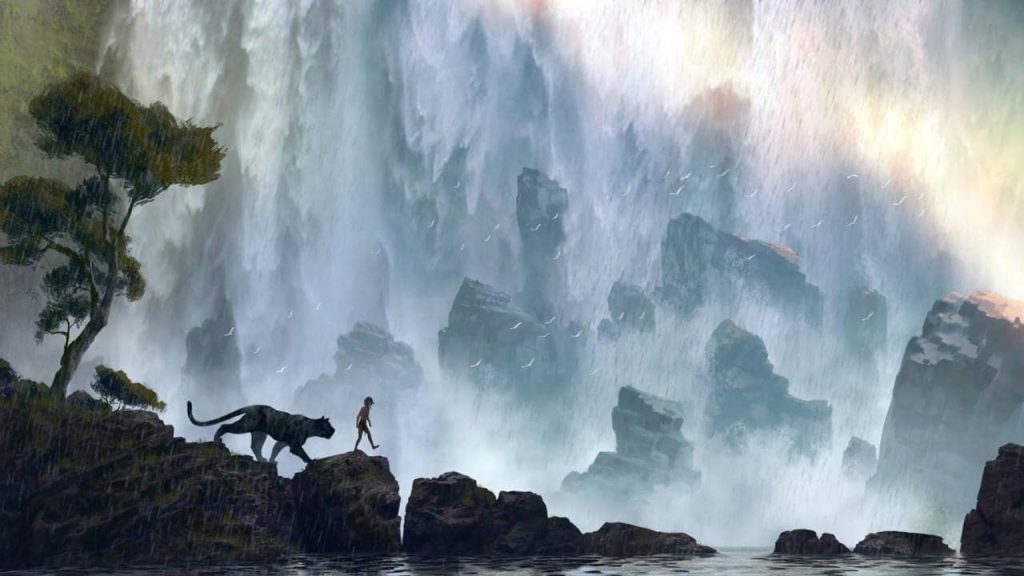
“The elephants created this jungle…”: The Elephants of The Jungle Book
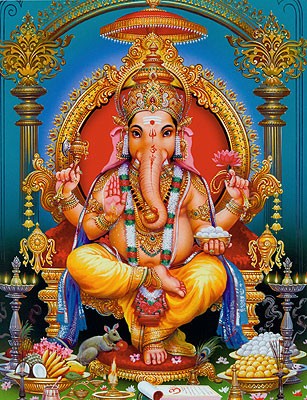
The representation of the elephants in the film is one of the most noticeable departures from the 1967 film. The Jungle Patrol in the 1967 film are a herd of elephants led by Colonel Hathi who conducts a military march. This makes him a fairly authoritative character within the jungle, but the marching scene is mostly remembered for the musical element that accompanies it, the goofy cartoon faces and the ease with which Mowgli plays with the baby elephant. Favreau’s elephants command respect in a comparable way, but their position is developed to the point where they are assigned divine powers within the Jungle and are credited with the creation of the whole environment. Ganesha is amongst the most worshipped in the Hindu pantheon which may explain Favreau’s decision in this case; a cultural link is insinuated with India, the country the film is set in, when the story had previously been accused of colonialist tones. They are the only significant characters in the film that do not speak, which works to assist this deity-like detachment from the other characters. In their first appearance the CGI elephants emerge from faded shapes in the distance with an almost dreamlike quality to them while Bagheera instructs Mowgli “bow your head, show them respect”. Majestic music accompanies the moment, and with Mowgli bowing on the floor, the low camera angle following his gaze up at them emphasises the sheer size of these animals. Although he is not in fear of attack as he is with Kaa and Shere Khan, we are aware of their magnitude and capability and the care and respect that one must caution as a result of this. This contributes to the more realistic style and a reduction of the carefree manner present previously.
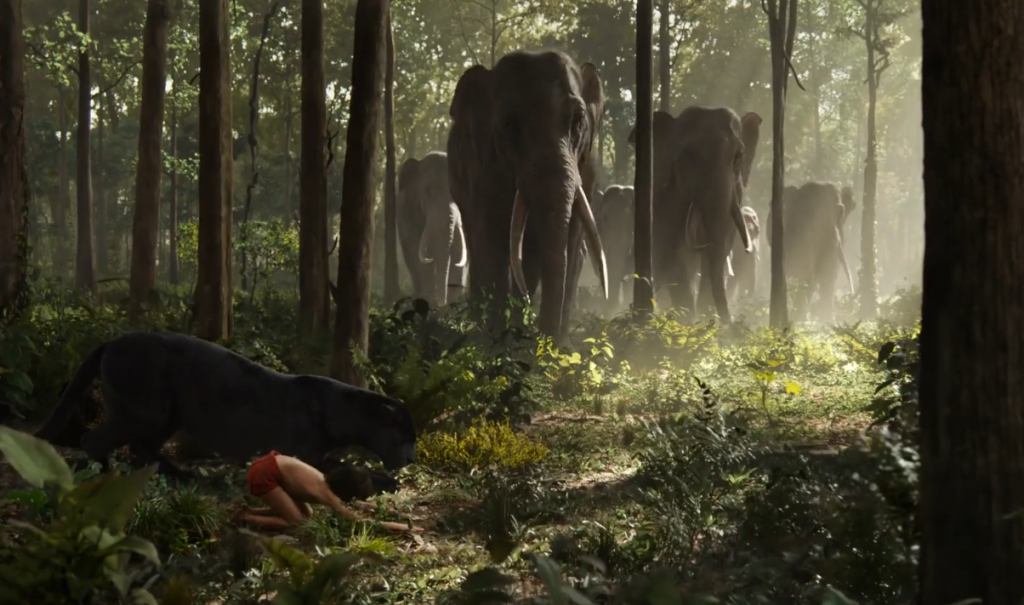
This essence is captivated in greater focus in a sub-plot between Mowgli and the baby elephant. Within the first appearance of the elephants, intense eye contact is captured between the pair in a prolonged shot-reverse-shot pattern. This is a nostalgic nod to the friendship that the two characters develop in the 1967 film, but the two do not touch, sing or play in the way which we were familiar. In a later appearance Mowgli is pictured amongst the herd of elephants while they aggressively swing their trunks around in the darkness. This creates a feeling of potential danger before it becomes apparent that Mowgli is constructing a contraption to rescue the baby elephant out of a ditch. Once he has done this the herd pull the baby back in protectively and Mowgli retreats to bow to them, reasserting the distance and respect. Their connection is then returned to in the closing scene after Mowgli accidentally causes a vast wildfire prior to defeating Shere Khan. The elephants realign the rivers with logs to extinguish the fire before Mowgli returns triumphantly to the other fearful animals on the baby elephant’s back. The return to the nature of the cartoon is appropriate in the form of the happy ending, heightening a nostalgic undertone. The build up to this is much more measured however, and conveys a message about the levels of respect necessary for interaction between man and elephants, which can then be applied to other species.
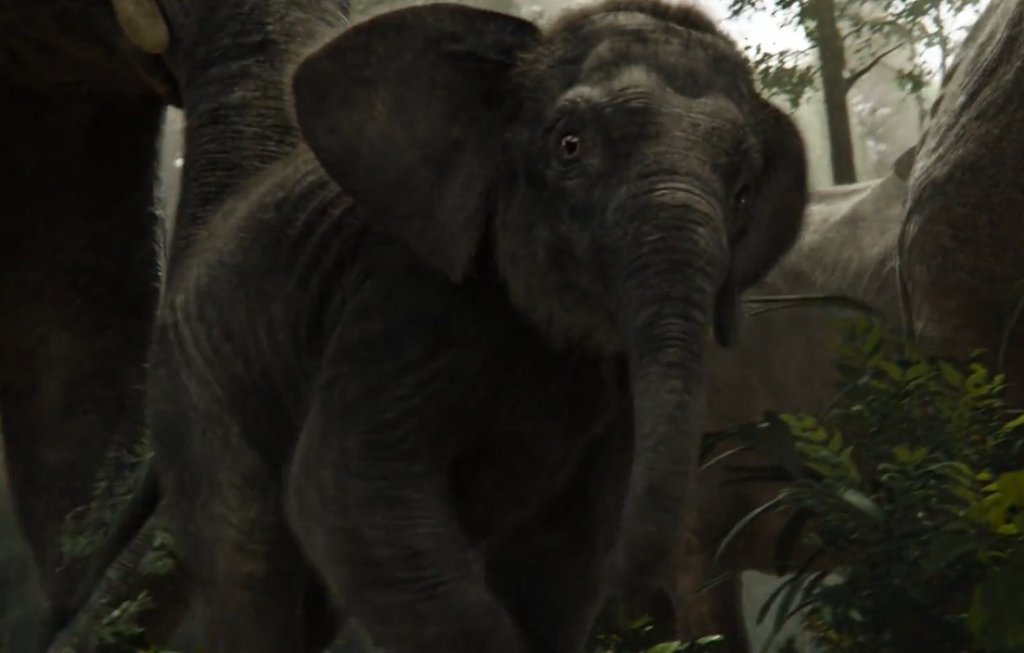
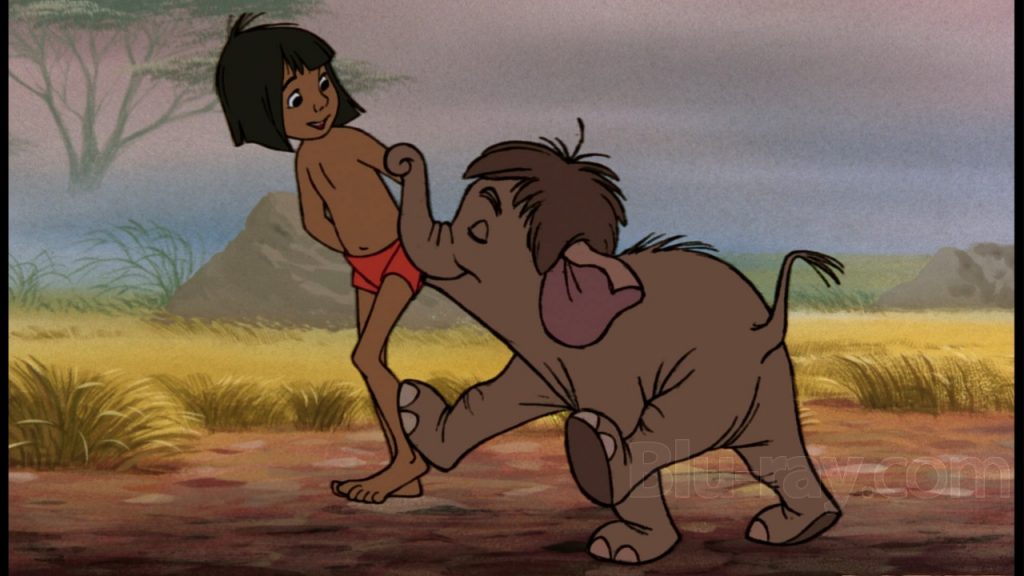
“…They created everything but they did not create you”: The Role of Jungle Territories in the Man Vs. Nature Binaries
The film was shot entirely in a studio in downtown LA, with CGI being responsible for the creation of the whole jungle environment and creatures within it that surround Mowgli. This enables visual effects that emphasise the tensions and danger of the world around him. An early example of this asserting the dominance of Shere Khan is when the conspiring Bengal tiger approaches and sits on the rock that the wolves are gathered on, shortly before an attack. Prior to his emergence the rocks appeared grey as if to signify that they belong to the wolves, but as Shere Khan takes comfort in invading their space, the lighting and structures alter to appear matched to the warmer tones and sharp stripes of his fur. The principles of animal adaptation and habitat are played on stylistically to subtly heighten a sense of danger throughout the action.
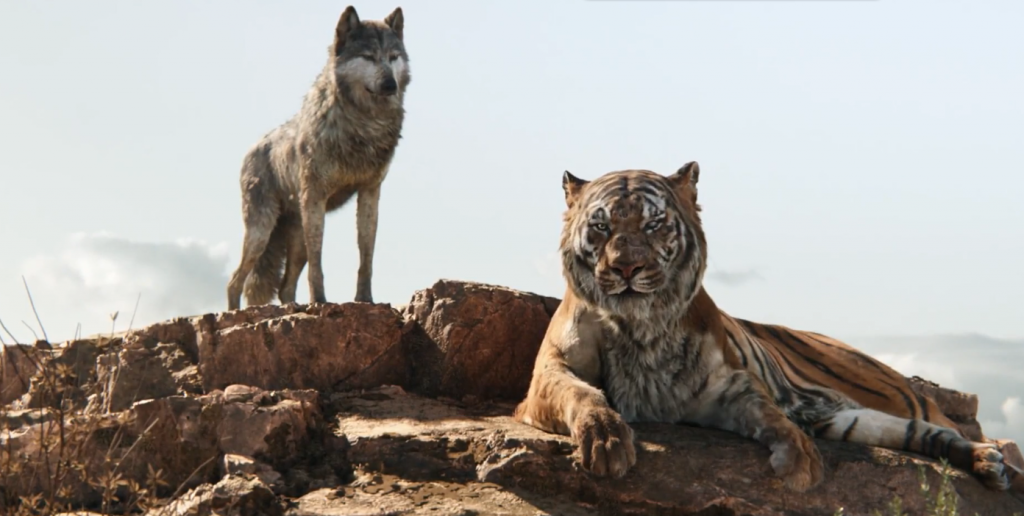
Just before Kaa the snake’s appearance, the trees that she hides amongst work in a similar way. The gloomy mise-en-scene entails striking structures of winding branches and vines in snake-like shapes, surrounding and dwarfing Mowgli in the centre of the frame. As a human, the viewer is put in Mowgli’s position, highly aware of the danger that the young boy is in in this situation and the lack of strength one can possess in a foreign territory.
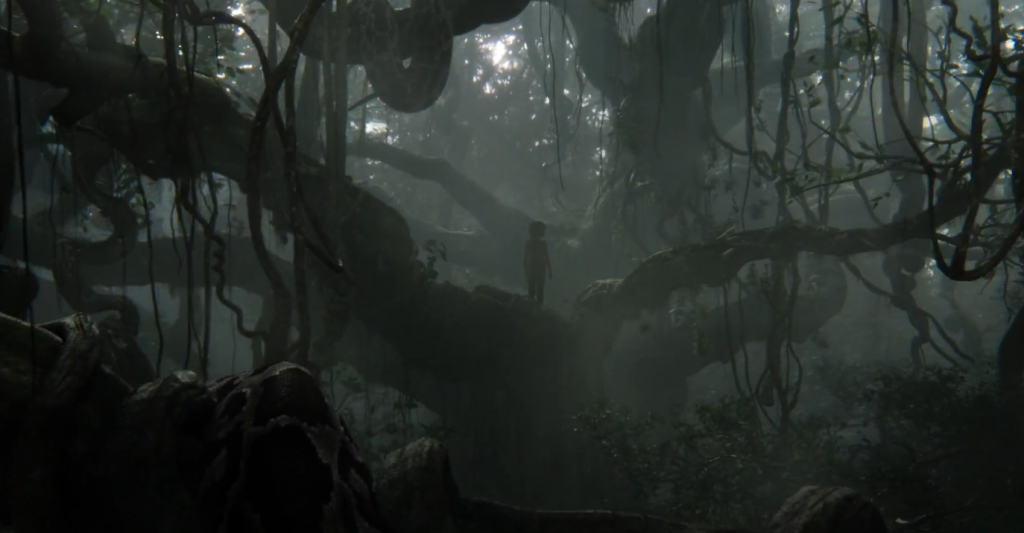
This effect is not always used to evoke danger. As Baloo and Mowgli float down the river singing ‘The Bare Necessities’ their surroundings appear more saturated in colour, enhancing blooming flowers and an upbeat mood. The overarching impact of this visual technique in terms of the relationship between Mowgli and the jungle is that this is not his territory and he is mostly not as much in control as others. A man vs. nature binary is in constant construction throughout his escorting out of the jungle.

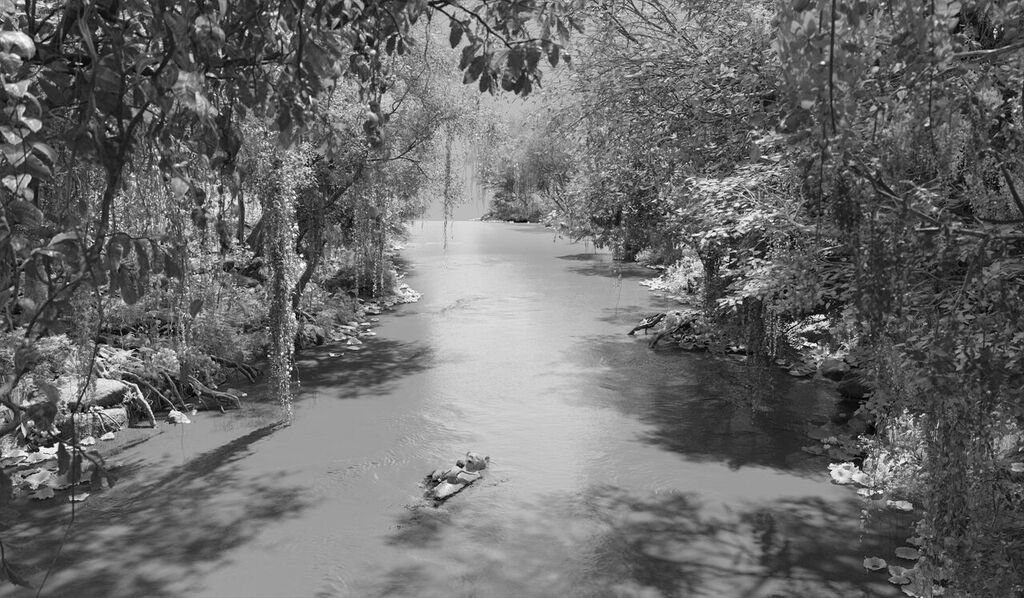
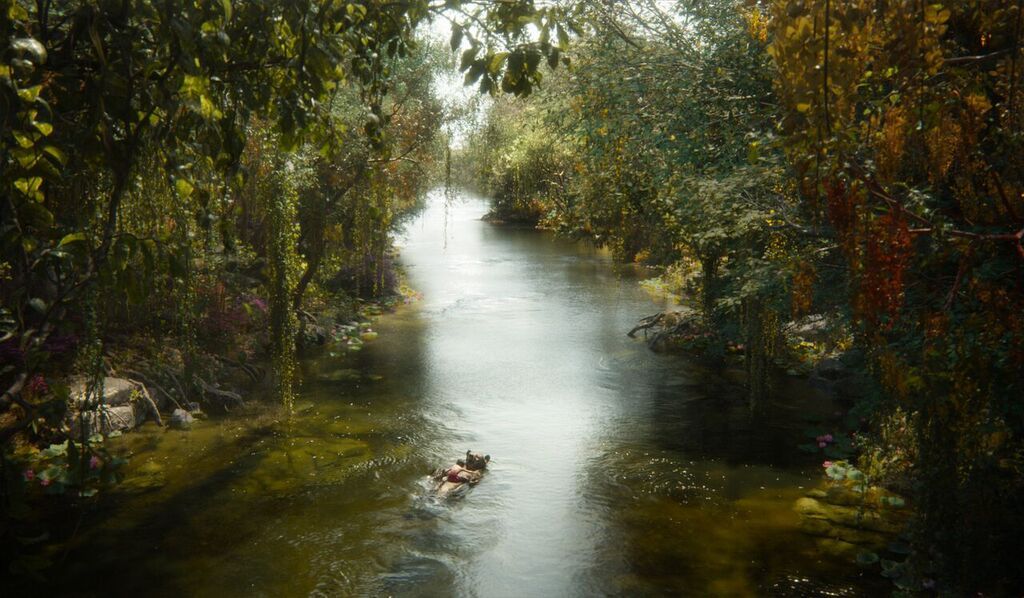
“It’s almost like some kind of Man-Cub”: The Human Within The Wilderness
From an anthropocentric angle, this variety of animal experiences can be interpreted as of greatest significance due to their influence on Mowgli as man and protagonist with emphasis given to the film’s position as a feral tale. Feral tales are narratives that explore the raising of a child isolated from civilisation. Kenneth Kidd interpreted the ballooning of this narrative trend in the 19th and 20th Century as due to the symbolic discourse that they provided about the wildness of boys.[3] In this sense, the animals of The Jungle Book are symbolic forces of character development. This notion surfaces in initiative new ways due to the modern cinematic advancements in technology.
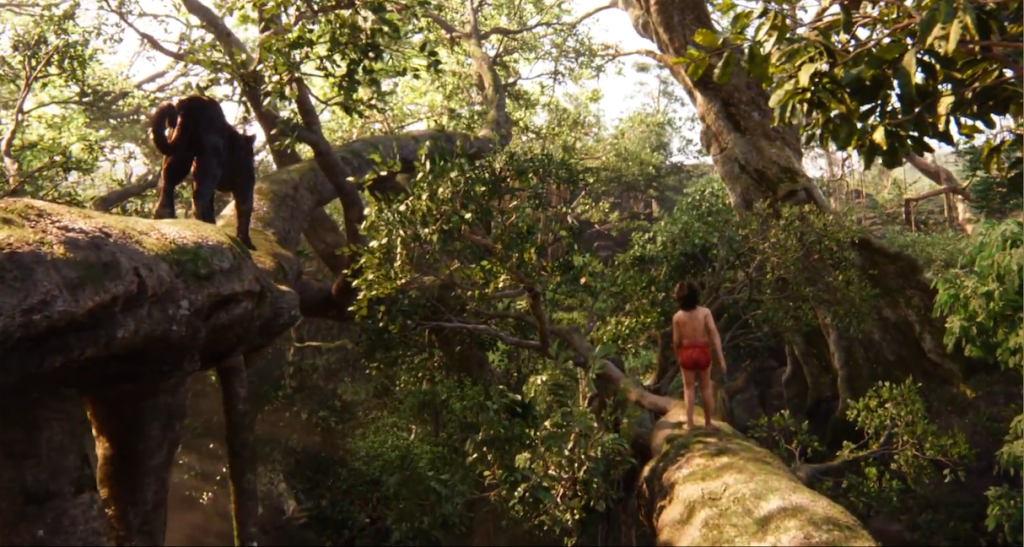
His hybrid labelling as “man-cub” remains; despite the emphasis on his differences with his environment, he remains a boy raised by wolves and has inherited parts of their nature. He is assigned animalistic attributes such as the way that he occupies space, effortlessly running up and through trees and jumping over ditches; these are captured by panning shots that make his movements more impressive and suited to the action genre. In appearance, his skin is covered in marks although he lacks injury, implying a robust nature for a small boy that makes him more suited to living in the wild. Certain shots emphasise his likeness to the other wolf cubs that he has been raised with, where the marks on him resemble their fur. This is another way that the use of CGI helps to create subtle likenesses and senses of belonging that may not have been achievable otherwise.
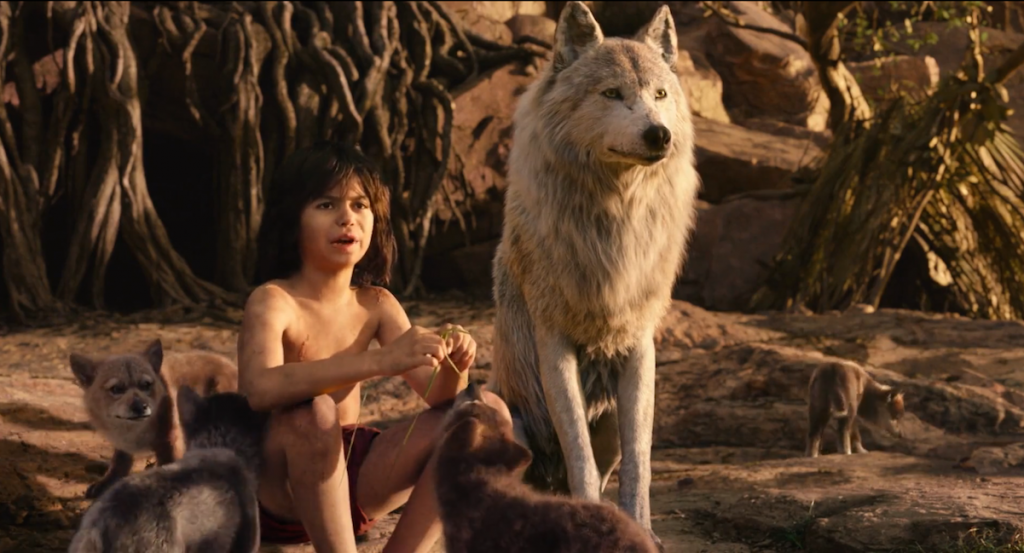
What keeps him isolated as man is that is that the kind of ability and power that he possesses are beyond the animals’ capability. This is shown through the way that he cunningly makes tools and contraptions to help the other animals, but is increasingly drawn into the concept of making fire or the so-called “the red flower”. This is what contributes to Shere Khan’s hatred and King Louie’s envy. In the end, it is Mowgli’s seizing of the flaming torch that sets the forest on fire and kills Shere Khan in the process. Further exploration of the ending leads into summative discussion on man’s relationship with the environment, with animals coming as a part of this.
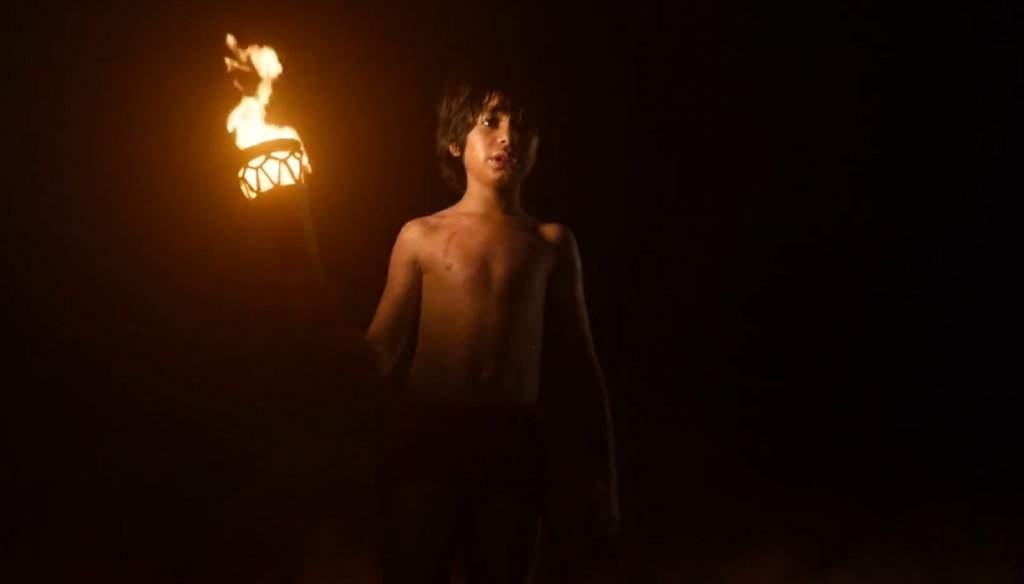
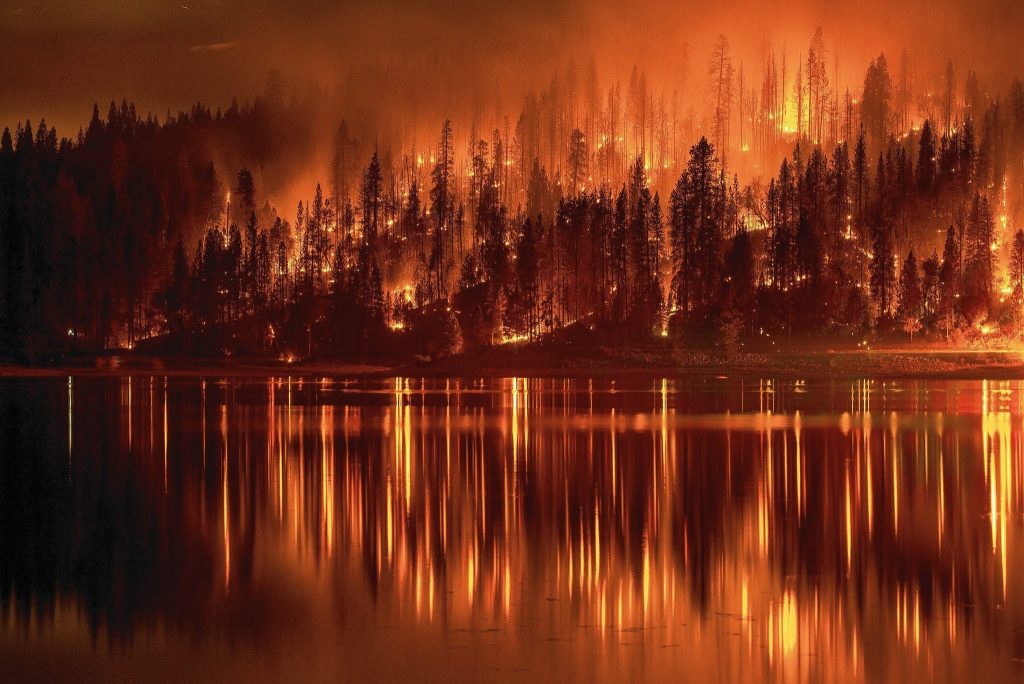
Critics such as Matt Zoller Seitz have deemed the film’s politics as “optimist environmentalist fantasy” due to Mowgli’s ingenuity in solving problems for his animal friends [4], whether this is with the elephants, helping Baloo get honey, or the defeat of Shere Khan. The underlying message about man’s capability for destruction disputes this to an extent. There is truth in Shere Khan’s words beneath his hostile sneers: “Does my face not remind you of what a grown man can do?”. Despite his role as the villain, many viewers will be aware of the endangered status of the Bengal tiger due to wildlife poaching. The wildfire scene at the end can also be seen as political commentary. Although the omnipotence of the mighty elephants prevents disaster, the event draws attention to the impact that one man’s carelessness can have, which can be read as topical in relation to issues such as deforestation and climate change that destroy the habitats of many. In discussion about the consequences of modernity, Akira Mizuta Lippitnotes that “animality ceases to occupy a proper space apart from the humanity that succeeds, appropriates and enframes it”.[5] This is certainly something that the film probes at, subtly promoting measures that should be taken to prevent humans taking an overbearing approach on the animal world.
Wells disputes Lippit’s position by arguing that it ignores hierarchy, and merely sees difference.[6] This sense of hierarchy is relevant when returning to the effect of wild animals on shaping the human protagonist. In a symbolic sense, Mowgli’s journey and experiences with animals can be seen as allegorical of other experiences of hierarchy impacting a child’s path into the adult world. The elements of danger, power dynamics and adaptive responses to different characters are relevant when exploring how children’s personalities are developed while growing up. The plot is comparable to that of the Alice in Wonderland films (1951 and 2010) in this sense, although operating in cooperation with environmental awareness opposed to the fantasy land that the latter toys with.
The 2016 Jungle Book possesses a depth that encourages a serious approach to nature and the animal world in our increasingly environmentally conscious age. With the subtlety of this and the manner in which it’s formed beneath an incredibly aesthetically pleasing surface, a feel good mood resonates with the film’s end, albeit a more politically evolved one.
Further Reading References
Official extended trailer
The Guardian reviews: https://www.theguardian.com/film/2016/apr/12/the-jungle-book-review
More about CGI in The Jungle Book
More academic analysis about the Jungle Book’s narrative
Ellen Brinks – Uncovering the Child in Timothy Treadwell’s Feral Tale
Jopi Nyman – Re-reading Rudyard Kipling’s ‘English’ Heroism: Narrating Nation in the Jungle Book
Bibliography
Hall, Jacob, New the jungle book images show off extraordinary VFX (Slashfilm, 2016), <http://www.slashfilm.com/the-jungle-book-images-vfx/> [accessed 15 January 2017]
Kidd, Kenneth, Making American Boys: Boyology and the Feral Tale (Minneapolis: University of Minnesota Press, 2004)
Lippit, Akira Mizuta, Electric Animal: Toward a Rhetoric of Wildlife (Minneapolis: University of Minnesota Press, 2000)
Nemiroff, Perri, Jon Favreau talks CHEF, making a personal movie, THE JUNGLE BOOK, MAGIC KINGDOM, and more at SXSW (Collider, 2014), <http://collider.com/jon-favreau-chef-jungle-book-magic-kingdom-interview/> [accessed 15 January 2017]
Wells, Paul, The Animated Bestiary: Animals, Cartoons, and Culture (London: Rutgers University Press, 2008)
Zoller Seitz, Matt, The Jungle Book Review (2016), <http://www.rogerebert.com/reviews/the-jungle-book-2016> [accessed 15 January 2017]
[1] Jacob Hall, New the jungle book images show off extraordinary VFX (Slashfilm, 2016), <http://www.slashfilm.com/the-jungle-book-images-vfx/> [accessed 15 January 2017].
[2] Perri Nemiroff, Jon Favreau talks CHEF, making a personal movie, THE JUNGLE BOOK, MAGIC KINGDOM, and more at SXSW (Collider, 2014), <http://collider.com/jon-favreau-chef-jungle-book-magic-kingdom-interview/> [accessed 15 January 2017].
[3] Kidd, Kenneth, Making American Boys: Boyology and the Feral Tale (Minneapolis: University of Minnesota Press, 2004), p17.
[4] Matt Zoller Seitz, The Jungle Book Review (2016), <http://www.rogerebert.com/reviews/the-jungle-book-2016> [accessed 15 January 2017].
[5] Akira Mizuta Lippit, Electric Animal: Toward a Rhetoric of Wildlife (Minneapolis: University of Minnesota Press, 2000), p53.
[6] Paul Wells, The Animated Bestiary: Animals, Cartoons, and Culture (London: Rutgers University Press, 2008), p31.